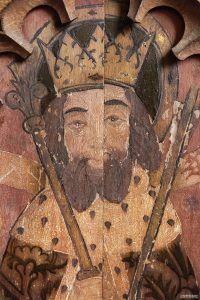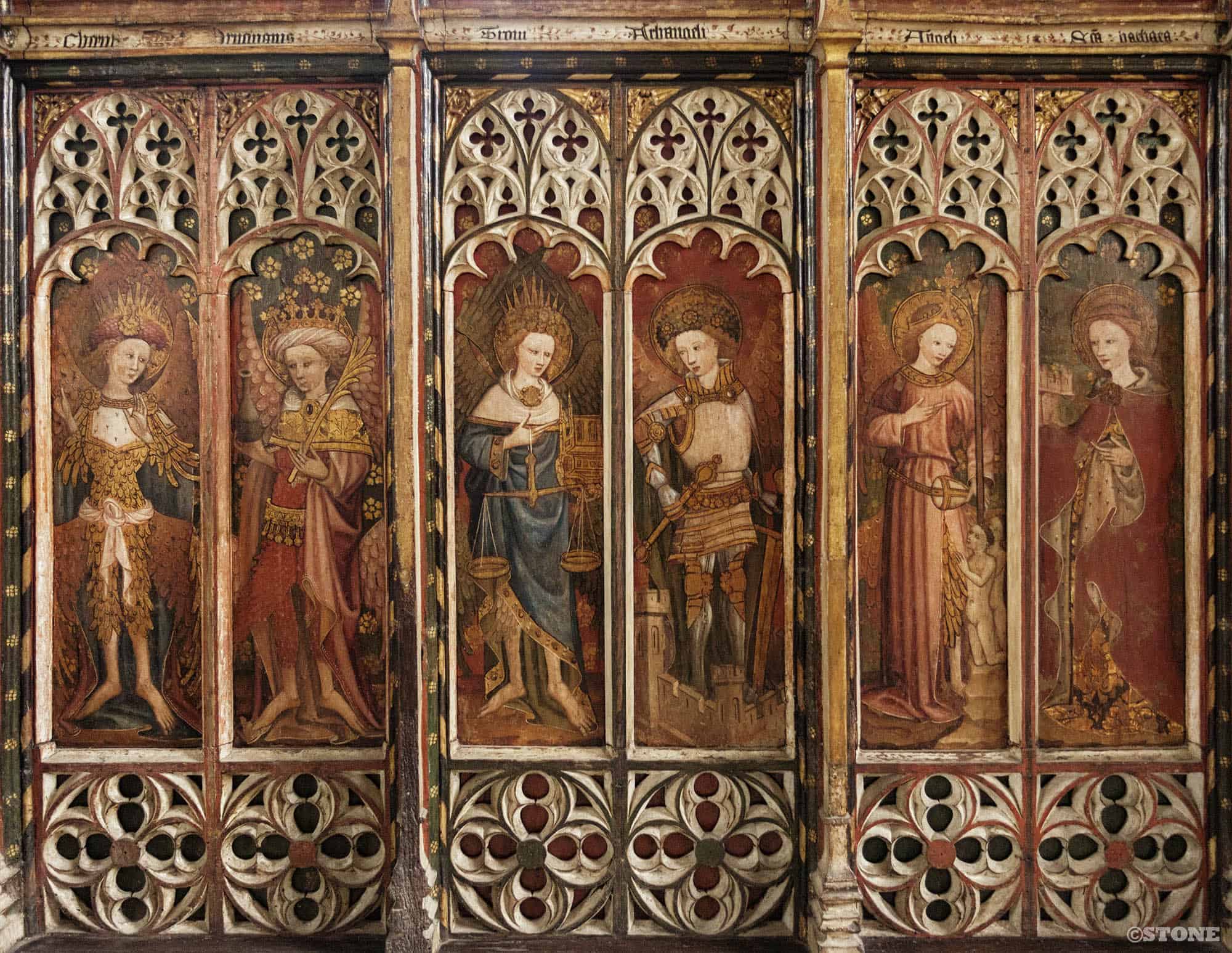Barton Turf – White light and angels.
It rained, my god how it rained. A bank holiday hex hanging over Easter. And typically the patterns of various occupations in one household left me on my own staring at a refracted sodden world as the cars trundling along Aylsham Road under a lead grey sky. I went shopping at Aldi, the car park a heaving nightmare, then sat and had a cup of tea and looked at the roiling underside of a colourless battleship of cloud rolling past our screen doors.
It’s distinctly undersea outside, the drive out towards Wroxham more of a swim, broken only by the slack curve of the new distributor road roundabout and the constant tick of wiper blades. There’s a lack of cars, towards the Broads the roads are emptier still, the fields are starting to fill with a film of water, grey reflected back up in the limited light. Some of the the side roads which angle off into the networks of old field boundaries are already running like sluice-ways, others into the villages are heavy with engine stopping puddles that stretch from already filled ditches right across the tarmac with nowhere to go.
It’s cold outside, So Gary was right all along, and still pouring down like there’s no end to it, but why let greyness get in the way of seeing some colour and light. Barton Turf is sodden, the lychgate dripping away, a water-darkened hulk of a memorial in this light. It’s an unusual one, I’m informed by a friend who knows about these things there are only about 250 memorial lychgates in Britain. I’ve noticed two, this and Edingthorpe, now I do tend to check them just in case. This is very much one of them. The fields slumber away beyond wetly as I sit inside it in the dry and read off the names. It’s quite captivating even in the rain, the murky trees across the field framed perfectly through gap it makes in time. So many people will have passed through here.
Inside St Michael and All Angels there’s a display on a trestle table, a book full of carefully printed and annotated sheets listing all the men lost in the parish, three panels of photographs and documents showing some of them and the investiture of the lychgate in 1922, a monochrome crowd gathered around it just off the road in the then fairly recently added extension to the cemetery on the side of a side road of a side road in the trees.
 I’ve been in here before, it’s one of those churches that it would be stupid to not go in. I came here in my teens with a group of people, we also went to Ranworth, which is a feast in itself, but always a bit too busy. Barton Turf is less busy, less known, on a day like today it’s empty and dry and perfect. When I first came I didn’t take enough notice so I came back last year when lottery money was being poured into repairs to the roof and chancel arch which I think had a largish crack in it sitting as it does on this soft bed of Broadland loam, things shift on their footings and break apart.
I’ve been in here before, it’s one of those churches that it would be stupid to not go in. I came here in my teens with a group of people, we also went to Ranworth, which is a feast in itself, but always a bit too busy. Barton Turf is less busy, less known, on a day like today it’s empty and dry and perfect. When I first came I didn’t take enough notice so I came back last year when lottery money was being poured into repairs to the roof and chancel arch which I think had a largish crack in it sitting as it does on this soft bed of Broadland loam, things shift on their footings and break apart.
The rood screen in here is probably about as good as you are likely to see anywhere, and reasonably untouched by the claws of the reformation, two faces have been scratched out, but the rest are intact. It also has an extra panel, a parclose screen to one side which features St Olaf and St Edmund, I don’t know why, but there’s something curious about an Anglian King next to a Norwegian one, both as obscured by hagiography as they are now by an unfortunately placed chest of drawers. Two saints, representing different waves of invaders and ultimately settlers in the soft damp flatlands of the Broads remembered in paint.
The main screens are beautiful, colour-filled affairs. Both female saints and Angels in all their forms. The north side starts with St Apollonia with tooth and pliers, St Sitha with household keys, and then four angels: powers, virtues, dominions and seraphim. The south range features cherubim, principalities, thrones, archangels and angels, and ends with St Barbara and her tower. The detailing, colour and the elements surrounding the figures are astonishing. I think my favourite screen in Norfolk, worth the struggle to photograph them adequately in the cloud filtered light. Then there’s some medieval glass fragments, again beautiful, the colours barely faded. People arrive, brollied up, they’re quiet, but the spell stretches out thin and snaps. So I head back out into the rain.
This landscape, this faint rise up to the main road tells other stories, Barton Turf touches RAF Neatishead, home to the radar museum, the longest serving one in the world, listening and watching from 1941 onwards until fairly recently. This is a Cold War landscape, and while the rain might sap your body heat, the Cold War control room in the old base a mile away carries a far heftier chill. I visited once, a year or so ago. A restored Bloodhound Missile stands sentry outside, tip poised ready to flense the sky. The defunct rotor sits stationary, gathering nothing but bird shit and leaves, Once upon a time it’s alleged it could fry a gull, so powerful were the microwaves.
We were shown around by an ex-RAF chap who had served in an almost identical station in Germany. The group asked questions against a wall of lights, maps and controls. Some of the matter-of-fact answers, the details about what would have happened in the event of a nuclear attack froze me to the core, the Okay well if that’s it, if we’re all done, hit them with everything we have and fuck ’em attitude of a society that existed in the shadow of annihilation. The eighties a previous high water mark of filth and malice between East and West, something that several generations can remember very well, it still haunts my dreams. The drips of that created radiating overlapping circles in those generation’s points of reference; from music and art to film and performance. And here we are again with fools at the controls on all sides again. Ho hum.
At the top of the hill near the junction, there’s what I think might be a radar signal booster station. It’s still wired off, MOD private land signs on all sides. It’s surrounded by small pillboxes, like a slab of banal hate echoing on. The church is in a hollow below. This stuff is all around here. This is Cold War Norfolk. The rain intensifies again, I’m wet through and haven’t quite finished sight-seeing. Not far from here is another little pool of memory for someone. On School Road, between Threehammer Common and Butchers Common in the village, is a house. It’s a short swim at the moment, so I drive. I arrive at a gate, It’s fenced off and signposted as private to deter the curious. It looks like a rather dull house which was the intention, because a boring house isn’t a target. It’s actually a rotor generator back up station and may have been an auxiliary battle headquarters had the rotor a quarter of a mile away been knocked out by the fierce, hot light. It’s quite forlorn, a planning application is pinned to a post nearby. An end in sight, angels all.

A declaration
Of the intention
To stop extension into my airspace
I’ll put the flags up
Pull up the anchor
And then you’ll know you’re in a different place
But I can’t stand up, and I can’t sit down
Cause a great big problem stopped me in my tracks
I can’t relax cause I haven’t done a thing
And I can’t do a thing cause I can’t relax
You’ve got your habits
I’ve got my customs
I’m sure you know it’s got to be this way
No hesitation
And in the future
We’ll celebrate our Independence Day
Independence Day
Hang out the flags, ring in the new
We should be dancing on the city streets
I know the tune, I know the words
My mouth is open but I cannot speak
S.Fellows.








very interesting, and great pics too..!
Long live the Comsats.
Another great read Nick. Good stuff
Enjoyed this wee day out, in the murk and wet. That Radar Museum can be Episode 5 of the Museums: Small & Perfectly Formed series Nick.
My song choice: Flag Day – The Housemartins